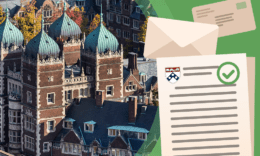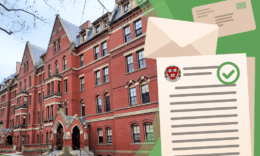Located just outside Boston in Cambridge, Massachusetts, United States, the Massachusetts Institute of Technology (MIT) is a prestigious private research university. MIT was founded in 1861 to fuel the industrial revolution in the United States. With notable alumni including Kofi Annan, Shirley Ann Jackson, and Buzz Aldrin, MIT sits at the forefront of science and technology research in the modern world.

While you might feel intimidated by this impressive bio, and the low acceptance rate, this post will break down every element of MIT’s Application Checklist to help you submit your best possible application.
MIT Statistics
How selective is MIT?
MIT is extremely selective, with an acceptance rate just below 4% for the Class of 2026.
Rankings
Currently ranked the #2 ranked institution of higher education in the United States, MIT offers its 4,638 undergraduates and 7,296 graduate students a plethora of opportunities with its $24.6 billion endowment and 3:1 student-to-faculty ratio.
SAT and ACT
MIT currently requires the SAT or ACT. The middle 50% of admitted students report Math SAT scores in the range of 790-800, SAT Evidence-based Reading and Writing of 730-780, and Composite ACT scores of 35-36.
GPA
The average admitted MIT applicant has a weighted GPA of 4.17, meaning accepted applicants generally receive only A’s and A-’s in high school. For instance, in 2021, 97% of MIT students scored in the top 10% of their classes.
Tuition and Financial Aid
The cost of attending MIT is $79,850 per year. MIT awards financial aid scholarships on a need-blind and full-need basis—meaning your ability to pay tuition is not considered in the admissions process, even if you’re an international student, and MIT commits to meeting 100% of your demonstrated financial need. For example, students who receive financial aid pay an average annual price of $12,715.

What Is MIT Looking For?
High School Coursework
Admissions officials expect to see a rigorous course load reflected in your transcript, but will not penalize you for courses your high school doesn’t offer. MIT recommends that students take the following courses in high school:
- Calculus
- One year or more of physics
- One year or more of chemistry
- One year or more of biology
- Four years of English
- Two years of a foreign language
- Two years of history/social sciences
Candidates who are well-matched for MIT have a strong grasp of math, physics, chemistry, and biology so try to take courses that demonstrate your familiarity with these fields.
Additionally, make sure to represent as diverse a range of interests as possible with your transcript—though MIT emphasizes math over art, humanities, and social sciences, a multi-faceted application will reflect your curiosity and show admissions officials you’re ready to take courses in those areas if accepted.
If your high school offers AP courses, IB courses, or any other advanced programming, you should take as many as you can manage to show admissions officials your willingness to challenge yourself. If your school doesn’t offer this kind of programming, consider enrolling in classes at your local community college, four-year college, or online—MIT allows you to report any courses you took outside of your high school.
The Interview
This part of the process is technically optional—but if MIT does offer you an interview with an alum, we strongly encourage you to take it. While it likely won’t make a huge difference in your admission chances, the interview is an opportunity for you to learn more about MIT from someone who actually went there, and for MIT to learn who you are beyond a set of grades and essays. Try to come prepared. Do your research about the school, be ready to answer basic questions about your future goals and specific interests, and bring a list of your own questions to show that you’re thoughtfully considering your application.
Remember that MIT offers interviews based on the availability of interviewers, so don’t worry if you don’t get offered one. If you do, expect either a virtual or in-person interview.
MIT Application Requirements
The Application
Firstly, you should note that MIT uses its own online application process, not the Common Application. The application differs between first-year and transfer applicants, so make sure you’re using the right portal.
Essays
Unlike many schools, MIT asks you to respond to four short-response questions with no long essay response. (See this great Next Admit post on How to Write the MIT Supplemental Essays for a question-by-question breakdown of each prompt.)
Application Fee
You must submit a $75 application fee or fee waiver.
Transcript
MIT requires a transcript as part of your application. Though this section is mostly out of your hands, make sure you look over your transcript before your school sends it over to catch any typos or vague course titles (e.g. “Math” instead of “Honors Pre-Calculus”). For a university with as strong an emphasis on STEM courses as MIT, you want to make sure your transcript accurately reflects the rigor of your coursework.
Secondary School Report
Your counselor will submit this alongside your transcript once you enter their information via the application portal.
Counselor Recommendation
Though MIT won’t penalize you if your counselor cannot or does not submit letters of recommendation, you should request one if possible. Try to sit down with your counselor beforehand so they can get to know you, and submit a recommendation letter that truly reflects your strong qualities as a person and student. You can request letters of recommendation through the MIT application portal before you submit it, so make sure you do so as early as possible to give your counselor adequate time.
Teacher Recommendations
MIT requires two letters of recommendation from teachers, and encourages you to submit one from a math/science teacher and one from a humanities, social science, or language teacher. If possible, try to follow this recommendation to show admissions officials your academic strengths across a range of subjects. As with your counselor, you should request a recommendation as soon as you know who to ask, so your teachers have ample time to write a detailed letter.
Try to ask teachers who know you as a person as well as a student. Make sure they’re aware of as many of your academic interests, passions, and hobbies as possible, or sit down with them beforehand—just like with your guidance counselor—if you feel you don’t know each other that well. The best letter of recommendation will come from a teacher who truly believes in your ability to succeed at MIT, even beyond your excellence in their class.
February Updates & Notes Form
This midyear report doesn’t require anything additional on your part except asking your counselor to submit it, and noting anything important that has happened since you submitted your application.
SAT or ACT
Again, note that unlike some other schools, MIT does require you to submit an SAT or ACT. You should self-report your scores on your application rather than submitting them officially—MIT will verify them independently if you are admitted.
If you take the SAT or ACT multiple times, admissions officials will only consider your highest score. If your scores fall outside the typical range for admitted students (listed above), and you’re able to take the test again, you should do so. Make use of any test prep resources available to you at your high school or online, and learn from your first experience before you take the test again—though if you end up scoring lower, this won’t work against your MIT application. However, bear in mind any other schools you’re applying to that might not superscore your standardized tests.
English Proficiency Exams
MIT strongly recommends English proficiency exams for non-native English speakers who have been using English for less than five years or don’t speak English at home or school. You can submit any of the following tests:
- Cambridge English Qualifications (C1 Advanced or C2 Proficiency)
- Duolingo English Test
- IELTS
- Pearson Test of English Academic
- TOEFL
Note that unlike SAT and ACT scores, MIT has minimum and recommended requirements for English language exams.
Extracurriculars
Firstly, be aware going into this section that you’ll only be able to put down four extracurriculars. You should prioritize activities that show admissions officials what you’re passionate about, and select a range of activity types rather than, say, four separate math camps. MIT also values leadership, so make sure to describe any leadership positions you’ve held.
If you still have some time before you apply to shop for extracurriculars, or you want to cross-reference your activities list with extracurriculars MIT students have taken in the past, these lists of enrichment opportunities and summer programs are a great place to look. Try to report at least one activity that meant a lot to you and matches well with previous MIT students—and if you can report multiple relevant activities across a range of subjects, all the better to show admissions officials you’re a good fit for their school.
Finally, MIT encourages you to report home responsibilities if you can’t fill out this section with formal extracurriculars. Even if you don’t have room for them here, you should mention them in your essay section to paint a fuller picture of what matters to you and how you spend your time.
Job Experience
MIT’s application includes a section for reporting job experience separate from its extracurricular section. Here, you should describe any paying job you’ve held in the past, with a particular emphasis on skills you gained and why the work was meaningful to you. When describing your first job, for instance, you might explain what you learned about the workforce in general to demonstrate your maturity, independence, and work ethic.
Deadlines
The deadline to apply Early Action to MIT’s is November 1, with decisions released online mid-December. Out of 11,924 applicants, 685 were accepted.
The Regular Decision deadline to apply to MIT is January 5. The deadline to take the required ACT or SAT is December 31, though MIT will still accept English proficiency exam scores through their January testing dates. The financial aid deadline for RA applicants is February 15, and RA applicants will receive decisions in mid-March.
Remember that MIT is one of the most competitive schools in the world, and try to bear in mind that even a stellar application doesn’t guarantee admission. Even an outright rejection doesn’t mean you’re not a strong student, or that you won’t excel elsewhere. Though MIT’s acceptance rate is low, the only way to guarantee you won’t get in is to not apply—so take note of the information above and give it your best shot!





